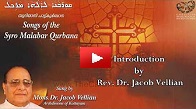
AP 80 to 71
Solemn sung Qurbana (Syriac). Msgr. Jacob Vellian.
| Call Number | AP 80 |
| Part Number | Part I - Syro Malabar Church |
| Title | Solemn sung Qurbana (Syriac). Msgr. Jacob Vellian. |
| Duration | 59:11 |
| Place of Recording | |
| Date of Recording | |
| Youtube URL | https://www.youtube.com/watch?v=xjdNCJjg548&t=552s |
| Video Segment (s) | AP 80a to 80z and 80aa to 80ag |
Solemn sung Qurbana (Syriac). Msgr. Jacob Vellian
This audio recording of the solemn sung Qurbana in Syriac is a significant addition to the archives of the Aramaic Project. The celebrant, Rev. Msgr. Dr. Jacob Vellian (b. 1934), is both an excellent singer and an accomplished scholar of the Syro Malabar liturgy. He grew up in the Syriac tradition. Due to unusual trajectories in life, Fr. Vellian, a member of the Knanaya community, was ordained in Rome and celebrated his first Qurbana in Syriac at the St. Peter’s Basilica. Ever since, Fr. Vellian kept the Syriac music tradition close to his heart. Even after the Syro Malabar Church promulgated the Malayalam version of the Chaldeo-Syriac liturgy in 1962, Dr. Vellian and several other priests in his community continued to celebrate Qurbana in Syriac on special occasions. Even when he celebrated the liturgy in the vernacular, Dr. Vellian would introduce one or two chants in Syriac to keep the awareness of the Syriac heritage alive in the community.
This recording represents the period in the history of the Syro Malabar Church, when Qurbana started with the minor doxology with the trope of alleluia. The dialogue between the celebrant and the congregation, Puqdankon/puqdaneh damsiha, during which the celebrant asked permission from the worshippers, came after the minor doxology.
One of the remarkable features of this recording is the presence of female voices. Traditionally, Syriac choirs did not include women. From the musical point of view, we hear a different performance practice of the Resurrection hymn (Laku mara) and the Trisagion (Qandisa alaha). The celebrant sings the melody first, and the choir repeats the same melody. At the third iteration, the celebrant and the choir alternate the verses. The first two iterations are set to 4/4 rhythm, whereas the third iteration is rhythmically free. The same performance practice is followed in the singing of the Trisagion. Similar to a practice among several Syro Malabar priests, Dr. Vellian applies the melody of the famous Latin chant, “exsultet” (from the Easter Vigil celebration in the Roman Catholic liturgy) to sing the Institution narrative. The recording also includes three examples of instrumental introduction/interludes, a common practice among Syriac choirs among the Syro Malabar communities. The idea of an opening overture may have come from the familiarity with the West European Opera overtures.
Currently, Dr. Vellian is living a retired life. Fortunately, this recording took place during his active years when his voice was in excellent shape. Dr. Vellian did a great service to the Syro Malabar Church by organizing this studio recording with the help of his accompanists. This is only one among the many valuable audio and video recordings that he bequeathed to Cultural historians of Kerala. This recording, in particular, will be useful to music scholars for a comparative study of melodies and performance practices among the priests who celebrate Syriac Qurbana of the Syro Malabar Church. The melodies of the solemn Qurbana are a goldmine for music researchers. Here we have a synthesis of several musical cultures from West Asia, Western Europe, and Kerala as well as a widow to the complex music history of the region. The Christian Musicological Society is immensely grateful to Dr. Vellian for granting permission to post this and several other precious recordings that he organized.
Dr. Joseph J. Palackal, CMI
New York
24 January 2018
Index
1. Introdution by Fr. JacobVellian in Malayalam (00:01)
2. Overture (1:50)
3. Minor doxology with alleluia (3:29)
4. Puqdankon (4:49
5. Thesbohtha (5:18)
6. Our Father with thrice holy (7:35)
7. Slotha (10:05)
8. Psalms (10:40) With trope of Alleluia
9. Slotha (12:05)
10. Laku Mara (12:50)
11. Slotha (16:17
12. Qandisa alaha (16:02)
13. Reading of epistle (19:29)
14. Alleluia (21:19)
15. Peace greeting and proclamation of the Gospel (21:55)
16. Slotha (23:10)
17. Karosutha (24:35) prayers of the faithful
18. Anthem of the mysteries (26:19) preparation of gifts
19. Commemoration hymn (27:41)
20. Creed (30:12) a different tune
21. Greeting and exchange of peace (32:40)
22. Holy, holy, holy (35:37) with musical interludes
23. Institution narrative (38:46)
24. Greeting (41:11)
25. Barek mar (41:40)
26. Rite of reconciliation (45:31)
27. Waswa lan (slotha (48:26)
28. Peace greeting (50:01)
29. Invitation to communion (51:20)
30. Maran iso, after communion (51:40)
31. Yayemar kol yawmin, concluding prayer 1 (52:50)
32. M’siha alahan, concluding prayer 2 (54:05)
33. Instrumental interlude (54:10)
34. Final blessing (55:22)
35. Instrumental coda (57:02)
Video Segments
- AP 80a - Puqdankon in Syriac Qurbana
- AP 80c - "Thesbohtha l'alāhā" (Glory to God) Excerpt from Solemn Qurbana in Syriac
- AP 80d - Our Father with thrice holy. Awun d'wasmayya
- AP 80e - Slotha-oration after the Lord's Prayer
- AP 80f - Psalms With Trope of Alleluia
- AP 80g - Slotha-oration after the psalms
- AP 80h - Lakumara - Resurrectioh hymn in Syriac
- AP 80i - Slotha-oration after the Resurrection hymn
- AP 80j - Qandisa Alaha- trisagion in Syriac
- AP 80k - Reading of Epistle in Syriac qurbana
- AP 80l - Alleluia in Syriac Qurbana
- AP 80m - Chanting of the Gospel in Syriac Qurbana
- AP 80n - Slotha -oration after the gospel proclamation
- AP 80o - Karosutha -Prayers of the faithful in Syriac qurbana
- AP 80p - Anthem Of The Misteries -pagare damsiha
- AP 80q - Commemoration Hymn- Suwha alaha in Syriac Qurbana
- AP 80r - The Creed in Syriac Qurbana. A different melody
- AP 80s - Greeings & Exchange Of Peace in Syriac Qurbana
- AP 80t - Holy Holy Holy/ Hosana in Syriac Qurbana
- AP 80u - Institution Narrative in Syriac Qurbana
- AP 80v - Greeting in Syriac Qurbana
- AP 80w - Barek Mar in Syriac Qurbana
- AP 80x - “Rahme Šūqānâ” Rite Of Reconciliation in Syriac Qurbana
- AP 80y - Waswa Lan in Syriac Qurbana
- AP 80z - Peace Greeting in Syriac Qurbana
- AP 80aa - Invitation To Communion in Syriac Qurbana
- AP 80ab - Maran Iso after Communion in Syriac Qurbana
- AP 80ac - Yayemar Kol Yawmin concluding Prayer 1 in Syriac Qurbana
- AP 80ad - M’siha Alahan concluding Prayer 2 in Syriac Qurbana
- AP 80ae - Instrumental Interlude in syriac Qurbana
- AP 80af - Final Blessing in Syriac Qurbana
- AP 80ag - Instrumental Coda in Syriac Qurbana
Related Videos
- AP 35 - "Suwha lawaa." Commemoration hymn from the solemn Qurbana in Syriac.
- AP 38 - Alleluia from the solemn Qurbana of the Syro Malabar Church in Syriac.
- AP 52a - Melody of "U al ar'a" (And on earth). Syriac translation of 'Gloria in Excelsis Deo'. From the solemn Qurbana in Syriac in the Syro Malabar Church before 1962.
- AP 52c - Sebastian Menachery sings and speaks about the chant, 'Barek Maar" (Bless O Lord) from solemn celebration of Qurbana in Syriac in the Syro Malabar Church.
- AP 52e - Melody of "M’haymneenan" from the Creed In Syriac during solemn celebration of Qurbana. Probabaly composed in Kerala
- AP 52m - Melody of "Ahai Qambel." which is the deacon's invitation to receive the holy communion from the Solemn Qurbana.
- AP 52n - Melody of “Rahme Suqaanaa”, from the reconciliation rite in the solemn Qurbana.
- AP 54f - Fr. Jose P. Kottaram sings "Thaibūthe d’māran īšōmišīhâ." Blessing and the Salutation and dialogue in solemn Qurbana: Syriac and Malayalam versions.
- AP 54g - Fr. Jose P. Kottaram sings two melodies of “Kad qāyēn” - the introduction to "Holy, Holy Holy" in solemn Qurbana in Syriac.
- AP 54h - Fr. Jose P. Kottaram sings "Yāēmār b’kōl yāwmīn" which is the slotha (prayer) before the Huthamma (final blessing) on Sundays in Qurbana in Syriac.
- AP 62cc - Melody of Final Blessing in Solemn Qurbana
- AP 70 - Fr. George Plathottam. Solemn sung Qurbana in Syriac
- AP 70h - Lākāu Mārā. Resurrection hymn from Syro Malabar Qurbana in Syriac
- AP 70n - Alleluia from Solemn Qurbana in Syriac. Celebrant: Fr. George Plathottam.
- AP 80c - "Thesbohtha l'alāhā" (Glory to God) Excerpt from Solemn Qurbana in Syriac
- AP 96 - Solemn Sung Qurbana in Syriac at Irinjalakkuda
- AP 100 - A Historic Event - Solemn Qurbana in Syriac
- AP 119 - Solemn Syriac Qurbana . Fr. Probus Perumalil, CMI. A musical treasure
- AP 122 - Fr Cyril Thayyil. Solemn Qurbana in Syriac. Koovappadam, Kochi
- AP 155 - Bishop Joseph Kallarangatt. Solemn Qurbana in Syriac. Elanji
- AP 156 - Fr Cyril Thayyil: Solemn Qurbana in Syriac at Kuravilangad
- AP 157 - Fr. George Nellikkatt: Solemn Qurbana in Syriac
- AP 165 - Solemn Qurbana in Syriac. Fr. Saji Mattathil, Fr. Joseph Pathil
- AP 172 - Fr Paul Kodamullil. Solemn Syriac Qurbana. Pre-1962 version
- AP 175 - Fr. Sebastian Sankoorikkal. Solemn Qurbana in Syriac (pre-1962 version)
- AP 335 - Syriac QURBANA| Newly ordained priest celebrates Syriac Qurbana at Vadavathoor



